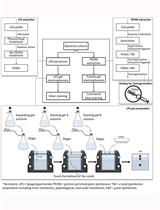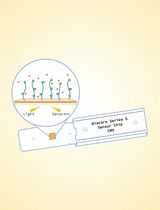- EN - English
- CN - 中文
Glycogen and Extracellular Glucose Estimation from Cyanobacteria Synechocystis sp. PCC 6803
蓝藻集胞藻PCC 6803中糖原和胞外葡萄糖估测
发布: 2018年05月05日第8卷第9期 DOI: 10.21769/BioProtoc.2826 浏览次数: 6760
评审: Anonymous reviewer(s)
Abstract
Cyanobacteria, which have the extraordinary ability to grow using sunlight and carbon dioxide, are emerging as a green host to produce value-added products. Exploitation of this highly promising host to make products may depend on the ability to modulate the glucose metabolic pathway; it is the key metabolic pathway that generates intermediates that feed many industrially important pathways. Thus, before cyanobacteria can be considered as a leading source to produce value-added products, we must understand the interaction between glucose metabolism and other important cellular activities such as photosynthesis and chlorophyll metabolism. Here we describe reproducible and reliable methods for measuring extracellular glucose and glycogen levels from cyanobacteria.
Keywords: Extracellular glucose (胞外葡萄糖)Background
Cyanobacteria have a light-dark cycle in their natural habitat. In the light, their metabolism is centered on photosynthesis, the Calvin cycle, glycolysis and the TCA cycle with N-assimilation; carbon is stored as glycogen. In the dark, glycogen is metabolized through glycolysis and the oxidative pentose phosphate (OPP) pathway, the oxidative and reductive branches of the TCA cycle, and the C4 cycle (Nagarajan et al., 2014). Thus, the shift from dark to light or light to dark drives metabolic reprogramming.
In the laboratory, the addition of glucose to the culture media also impacts cyanobacteria metabolic programs. For example, nutritional and environmental conditions influence how the cyanobacterium Synechocystis metabolizes glucose; Synechocystis metabolizes glucose differently in photoautotrophic, heterotrophic and mixotrophic conditions. Previous studies reported that some strains of Synechocystis are light-dependent and glucose tolerant (Anderson and McIntosh, 1991). Light-activated heterotrophic growth (LAHG) conditions are characterized by the presence of glucose and growth in the dark with a pulse of white or blue light for at least 5-15 min per day. However, some strains of Synechocystis are glucose intolerant, meaning that they cannot grow in the presence of glucose in the dark. In summary, the addition of glucose to the culture media of Synechocystis has been reported to bring physiological and metabolic changes such as pigmentation (Ryu et al., 2004), carbon metabolism (Lee et al., 2007; Takahashi et al., 2008), phosphorylation patterns (Bloye et al., 1992), carbon dioxide uptake (Kaplan and Reinhold, 1999), and oxidative stress generation (Narainsamy et al., 2013).
To identify the utility of cyanobacteria to produce natural product, growing cyanobacteria in large-scale is a prerequisite. For growing cyanobacteria efficiently, it’s important to characterize the direct impact of common environmental factors such as light and temperature on glucose metabolism. Here, we present an accurate, reproducible, and reliable method to quantify extracellular glucose and glycogen levels of cyanobacteria, we belelive that this method will help determine the utility of cyanobacteria as a source for engineering natural products.
Materials and Reagents
- Pipette tips (20 µl-1 ml, autoclaved)
- Aluminum foil
- 1.5 and 2 ml Eppendorf tubes (autoclaved)
- 0.45 µm filter
- Cyanobacteria Synechocystis sp. PCC 6803 (WT, mutant D95 & C95)
Note: For more information about these strains, please see Data analysis A4. - Sulfuric acid (ACS reagent, Sigma-Aldrich, catalog number: S1526 )
- Nitrogen
- Ethanol (Sigma-Aldrich, catalog number: 362808-1L )
- Glycogen (Thermo Fisher Scientific, Thermo ScientificTM, catalog number: R0561 )
- Amyloglucosidase (Sigma-Aldrich, catalog number: 10115-1G-F )
- Sodium carbonate (Na2CO3) (Sangon Biotech, catalog number: ST0840 )
- Sodium nitrate (NaNO3) (Sinopharm Chemical Reagent, catalog number: 10019918 )
- Hydrochloric acid (HCl) (Sinopharm Chemical Reagent, catalog number: 10011018 )
- Sodium hydroxide (NaOH) (Sangon Biotech, catalog number: SB0617 )
- Potassium phosphate dibasic (K2HPO4) (Sangon Biotech, catalog number: PB0447 )
- Magnesium sulfate heptahydrate (MgSO4·7H2O) (Sangon Biotech, catalog number: MT0864 )
- Ferric ammonium sulphate (Sangon Biotech, catalog number: A502657 )
- Citric acid (Sangon Biotech, catalog number: C0529 )
- Calcium chloride dihydrate (CaCl2·2H2O) (Sangon Biotech, catalog number: CT1331 )
- EDTA-Na2 (Sangon Biotech, catalog number: E0105 )
- Boric acid (H3BO3) (Sangon Biotech, catalog number: BB0044 )
- Manganese(II) chloride tetrahydrate (MnCl2·4H2O) (Sangon Biotech, catalog number: A500331 )
- Zinc sulfate heptahydrate (ZnSO4·7H2O) (Sangon Biotech, catalog number: A602906 )
- Sodium molybdate dehydrate (Na2MoO4·2H2O) (Sangon Biotech, catalog number: SB0865 )
- Copper(II) sulfate pentahydrate (CuSO4·5H2O) (Sangon Biotech, catalog number: A501425 )
- Cobalt(II) nitrate hexahydrate (Co(NO3)2·6H2O) (Sangon Biotech, catalog number: CB7774 )
- Sodium thiosulfate anhydrous (Na2S2O3) (Sangon Biotech, catalog number: S1712 )
- D-glucose (Sangon Biotech, catalog number: 501991 )
- Glucose standard solution (Sigma-Aldrich, catalog number: G3285 )
- Benzoic acid (Sinopharm Chemical Reagent, catalog number: 30018615 )
- Glucose oxidase/peroxidase (Sigma-Aldrich, catalog number: G3660 )
- o-Dianisidine reagent (Sigma-Aldrich, catalog number: D2679 )
- Potassium hydroxide (KOH) (Sigma-Aldrich, catalog number: P6310 )
- Sodium acetate (Sigma-Aldrich, catalog number: S2889 )
- TES, N-tris(hydroxymethyl)methyl-2-aminoethanesulfonic acid (Sangon Biotech, catalog number: TB0927 )
- BG-11 media (see Recipes)
- D-Glucose (see Recipes)
- Assay reagent (see Recipes)
- 30% (w/v) KOH (see Recipes)
- 100 mM sodium acetate (pH 4.5) (see Recipes)
Equipment
- Conical flasks (100, 200, 500 ml) (SHUNIU, Chengdu, China)
- Vortex (FINE PCR, model: Finevortex )
- Centrifuge machine, unrefrigerated, maximum speed 17,000 x g, with rotor for microtubes (Thermo Fisher Scientific, model: HeraeuesTM PicoTM 17 )
- Glass test tubes 18 x 150 mm
- Spectrophotometer (METASH, model: V-5600 )
- 1 ml glass cuvettes (METASH)
- Pipettes (20 µl, 200 µl, 1 ml, 5 ml) (Gilson, France)
- Water baths (temperature set at 37 ± 1 °C; 60 °C; 92 °C) (Meier, model: XMTD-204 )
- Shaking light-incubator (light:up to 150 µmoles/m2/sec; temperature: 20-50 °C) (Shanghai Zhichu, model: ZQWY-200G )
- Freeze dryer (Labconco, model: FreeZone Plus 6 )
- Oven, 60 °C (Boxun, model: GZX-9140MBE )
- Autoclave (Boxun, model: YXQ-LS-100SII )
- pH meter (Mettler Toledo, model: FE 20 )
- Swimming holders
Software
- GraphPad PRISM (Version 5.01)
Procedure
文章信息
版权信息
© 2018 The Authors; exclusive licensee Bio-protocol LLC.
如何引用
Khan, M. R. I., Wang, Y., Afrin, S., He, L. and Ma, G. (2018). Glycogen and Extracellular Glucose Estimation from Cyanobacteria Synechocystis sp. PCC 6803. Bio-protocol 8(9): e2826. DOI: 10.21769/BioProtoc.2826.
分类
微生物学 > 微生物生物化学 > 糖类
生物化学 > 糖类 > 糖原
生物化学 > 糖类 > 多糖
您对这篇实验方法有问题吗?
在此处发布您的问题,我们将邀请本文作者来回答。同时,我们会将您的问题发布到Bio-protocol Exchange,以便寻求社区成员的帮助。
提问指南
+ 问题描述
写下详细的问题描述,包括所有有助于他人回答您问题的信息(例如实验过程、条件和相关图像等)。
Share
Bluesky
X
Copy link












